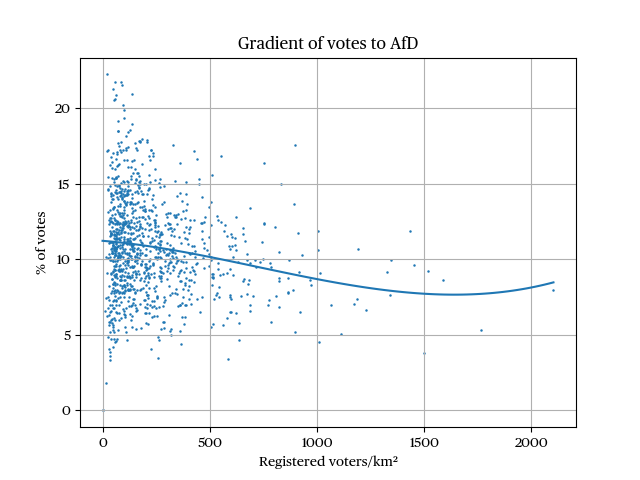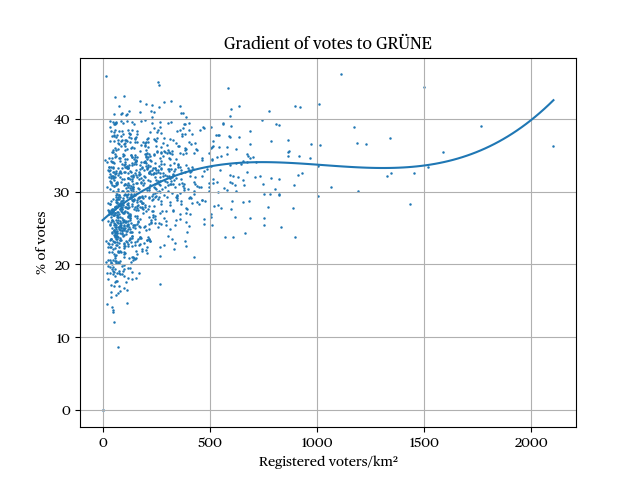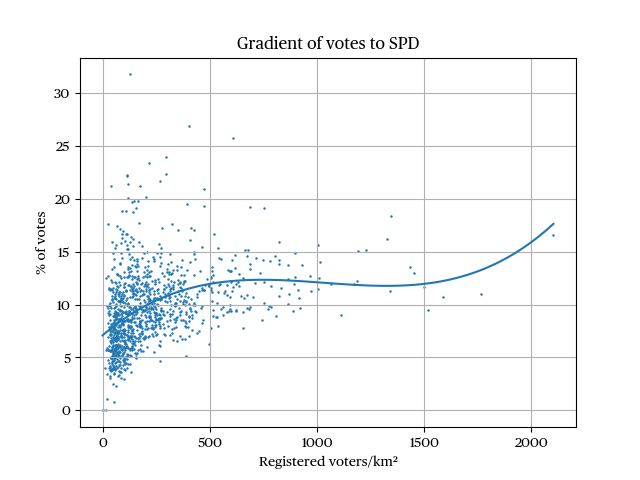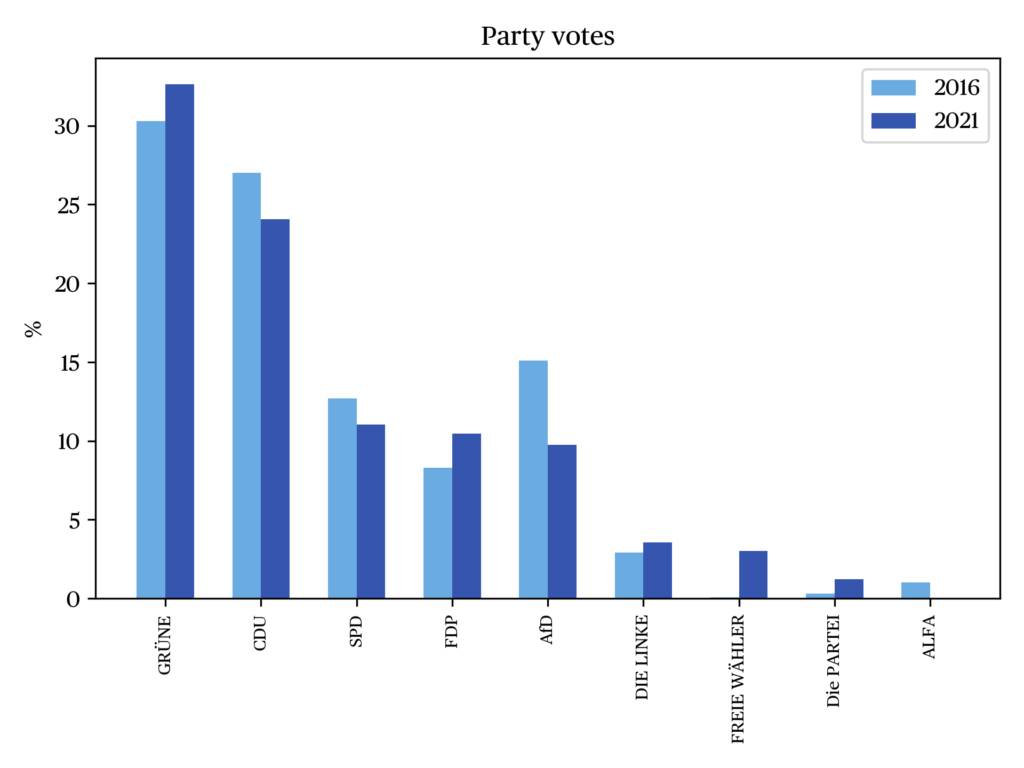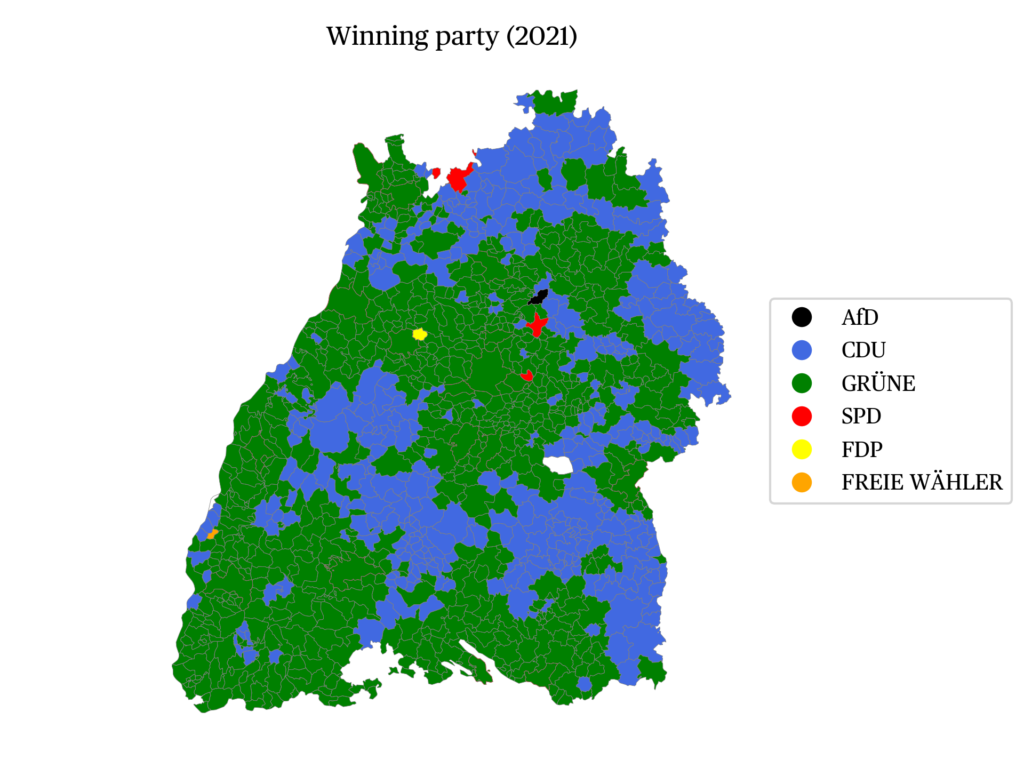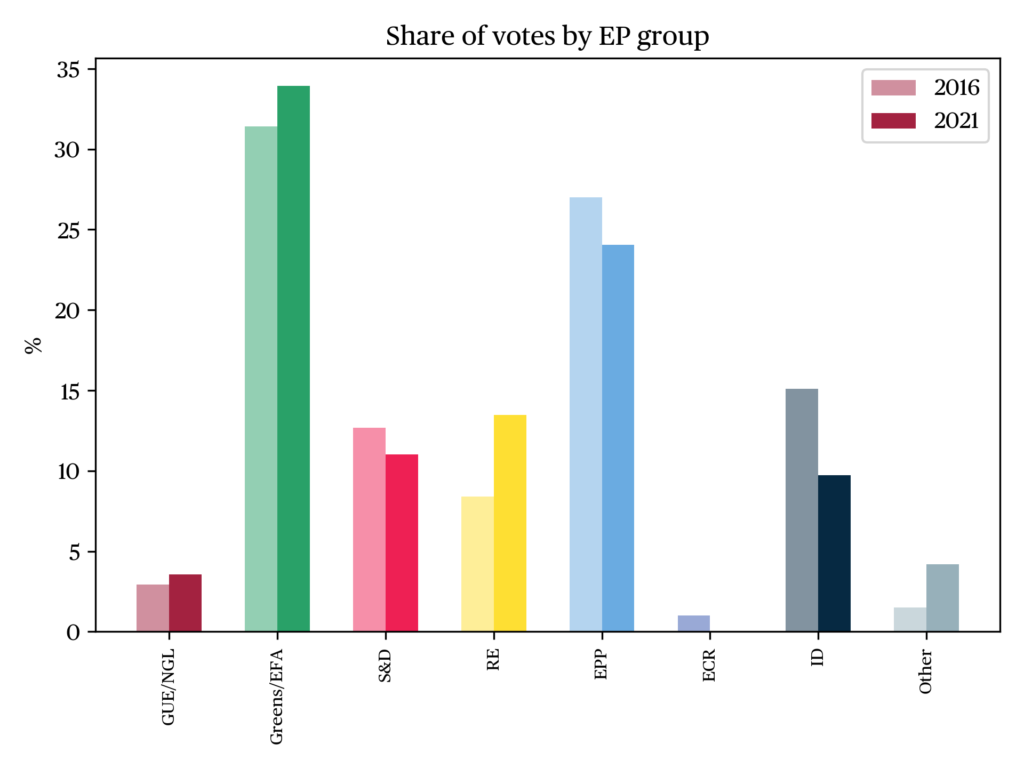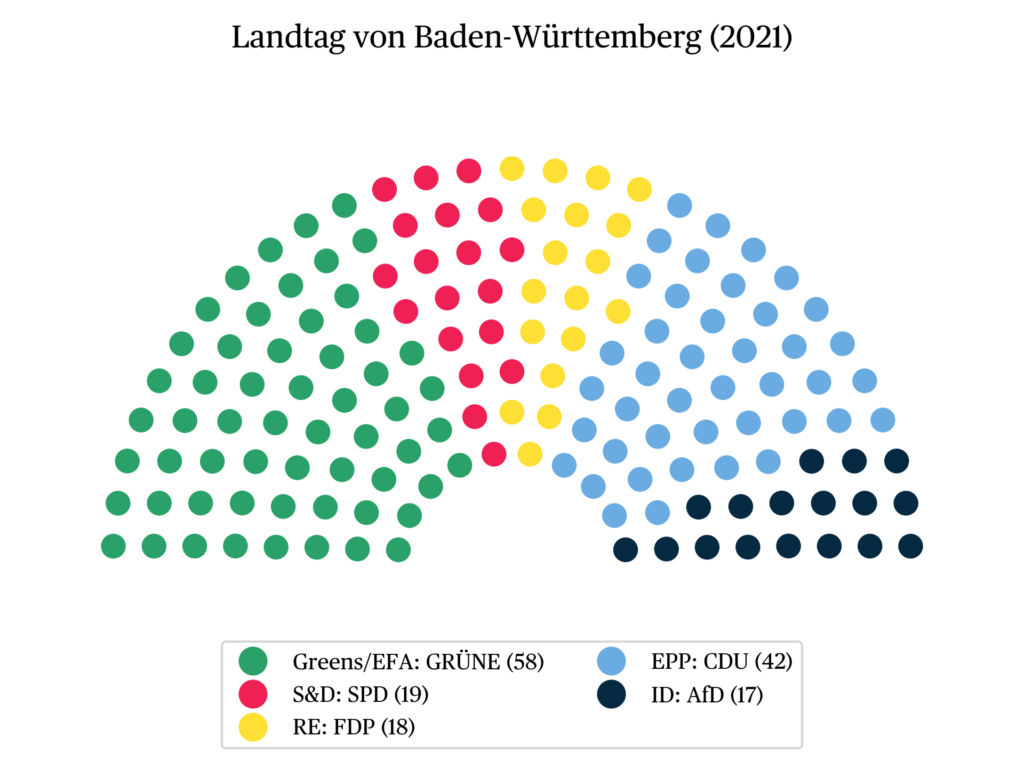Parliamentary Election in Baden-Württemberg, 14 March 2021

Oliver Drewes
Researcher, University of TrierIssue
Issue #1Auteurs
Oliver Drewes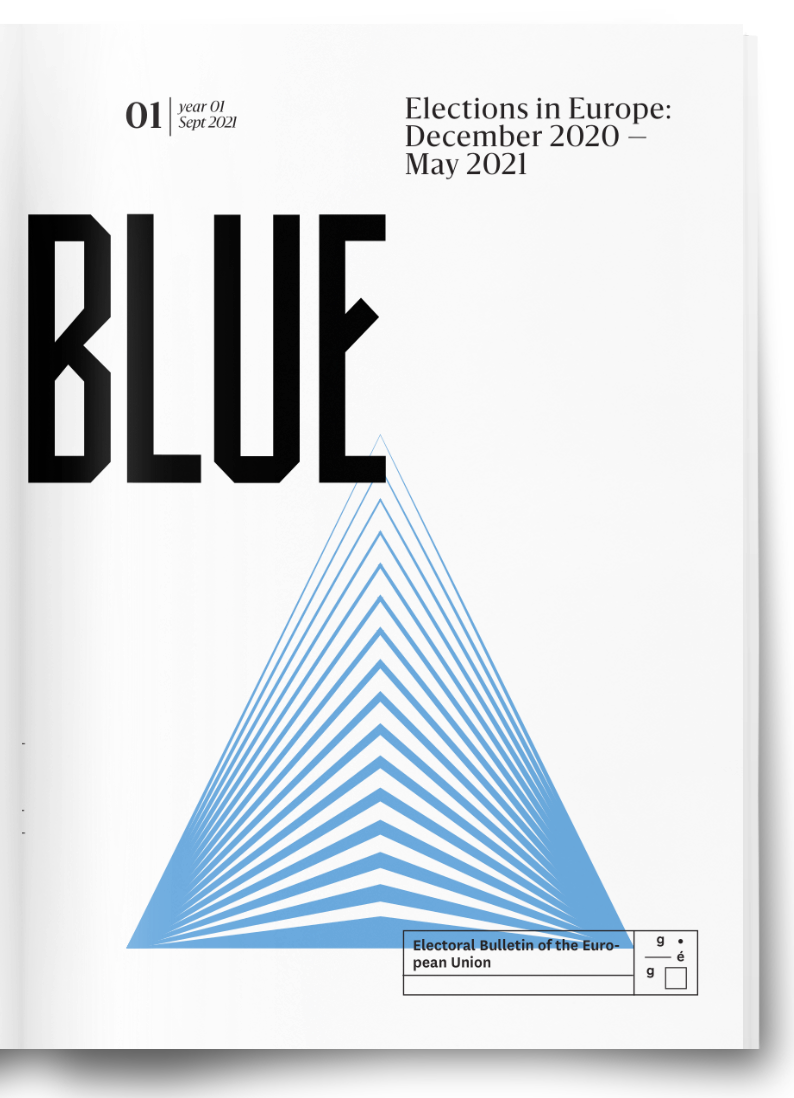
21x29,7cm - 102 pages Issue #1, September 2021 24,00€
Elections in Europe: December 2020 — May 2021
Introduction and context
In 2021, several important elections are due to be held in Germany. Besides the federal election which will take place in September, five state elections will be organised. In this so-called “super election year,” the first two regional elections were held in the Western states of Rhineland-Palatinate and Baden-Württemberg. In the months preceding a federal election, state elections are generally regarded as an indicator of nationwide political trends, and their results are watched particularly closely. Therefore, this analysis will also examine electoral outcomes in the perspective of the upcoming federal elections.
In this context, two circumstances deserve special consideration: first, the significance of the third candidacy of incumbent Minister President Winfried Kretschmann (Bündnis 90/Die Grünen; Greens/EFA) and, second, the characteristics of the electoral system in Baden-Württemberg.
Kretschmann has been Minister President since 2011. He first led a Green-Red coalition with the Social Democrats (SPD; S&D) between 2011 and 2016, and then the first Green-Black coalition with the Christian Democratic Union of Germany (CDU; EPP) on state level (2016 to 2021). Kretschmann’s high and stable approval ratings played a significant role in the continuation of the Green-Black government, and the strongly personalized campaign somewhat diminished the issue-oriented focus of party competition. At the same time, the Covid-19 pandemic benefited parties in executive roles and leadership positions, as the political focus in moments of crisis is clearly stronger on governing parties than on opposition parties.
Both the approval rating for Kretschmann as Minister President (between 67% and 84% since 2016) and the generally high level of approval of the state government’s work (between 60% and 70% for the most part) are remarkably high compared to other German states (Infratest dimap, 2021a). This popularity and degree of approval made it difficult for competing politicians to pose a threat to Kretschmann during the election campaign. In a direct comparison, 65% of the people surveyed would have voted for Kretschmann directly as Minister President shortly before the election, while only 17% would have voted for Susanne Eisenmann, his CDU challenger (ibid.). Comparing the approval rates of the two top candidates, it became clear that Kretschmann was perceived as significantly more likeable and credible and was attributed more expertise (Forschungsgruppe Wahlen, 2021a). Based on this large discrepancy, the CDU made a strategic mistake by conducting a personalized election campaign instead of one based on content (Brettschneider, 2021). Furthermore, the election campaign was challenging for the CDU since it had to mobilize against its own coalition partner. The role of junior partner in a coalition typically makes it difficult to attack the larger coalition party leading the government, since the CDU itself bears partial responsibility for the government’s performance. The relevance of political actors in Baden-Württemberg as well as their policymaking in this election was highlighted by the fact that 63% of respondents indicated that state politics had been a more important reason for their voting decision than federal politics (Forschungsgruppe Wahlen, 2021b). Therefore, in this context, the simultaneous nationwide upswing of the Green Party (INSA, 2021) should not be interpreted too strongly as a factor in this state election — the same applies for the CDU.
In addition to the significance of Kretschmann’s popularity ratings, the electoral system in Baden-Württemberg has a particular feature that needs to be noted in order to be able to understand the results: Unlike the standard German election mode with a first and second vote in federal and state elections, which are used to elect direct candidates in the electoral constituency and list positions on the party list, in Baden-Württemberg only one vote is cast to elect a person nominated by a party (or someone without a party affiliation). Since there are no state party lists, the election with one vote is simultaneously a proportional and a personal election, and each candidate must stand for election in one electoral constituency. 1 Therefore, a differentiated analysis of the popularity of party programs and party politicians is increasingly difficult. This shifts the focus of the analysis towards the performance of individual parties and politicians.
Results and changes in election results
The 2021 state election results showed only minor changes for most parties compared to the 2016 election. The Green Party gained 2.3 pp and the Free Democratic Party (FDP; RE) gained 2.2 pp, thereby seeing itself as the winner of the election. Meanwhile, the CDU lost 2.9 pp, the Social Democratic Party of Germany (SPD; S&D) 1.7 pp and the Alternative for Germany (AfD; ID) 5.4 pp (see “data” panel). For the AfD in particular, which thus slipped to 9.7% in total, the result represents a bitter setback due to the loss of a third of its voters, who had first elected the party to the state parliament in 2016. While the CDU admitted its electoral defeat due to the lost votes, the AfD had a harder time in this regard, instead pointing to the difficult circumstances of the election campaign. The Left Party (GUE/NGL) was able to increase slightly by 0.7 pp to a total of 3.6%, but once again missed entry into state parliament (five-percent hurdle). The Free Voters (RE) were also able to gain 2.9 pp, but with 3% of the votes in total they also missed the five-percent hurdle required for entry into the state parliament. In the run-up to the election, the Climate List Baden-Württemberg had attracted attention, promoting a more comprehensive and intensive climate policy than the Green Party. Although the Climate List only received 0.9% of the votes, these votes are mainly to the disadvantage of the Greens, whose potential to win mandates was thereby diminished, albeit to a small extent.
Compared to the 2016 election, voter turnout fell from 70.4% to 63.8% equivalent to 4,894,500 votes (Statistisches Landesamt Baden-Württemberg, 2021). The lower participation has a negative impact on the AfD in particular, as around 16.6% (equivalent to around 135,000 votes) of its 2016 voters did not turn out to vote in this election year, meanwhile the party was hardly able to gain any new voters (Intratest-dimap, 2021b). Likewise, 165,000 voters of the CDU abstained. Meanwhile the party also lost 145,000 voters to the Green Party, who was able to improve its result by gaining votes mainly from the CDU, the non-voters (105,000), the SPD (115,000) and new voters (90,000) (ibid.).
Performing a principal component analysis of voting behaviour at the municipal level, we can identify groups of municipalities whose voting behavior deviates from the average result. This allows, in particular, for a more detailed analysis of the electoral dynamics of centre-left parties. Most of the deviations (56%) from the average result can be attributed to an increase in Green and SPD votes in mainly urban areas, accompanied by a decrease in CDU and AfD votes (Figure a). In contrast, another 20% of the deviations, especially in the rural northern part of the country, are attributable to an increase in votes for the AfD, SPD and FDP and a decrease in votes for the Greens and CDU (Figure b).
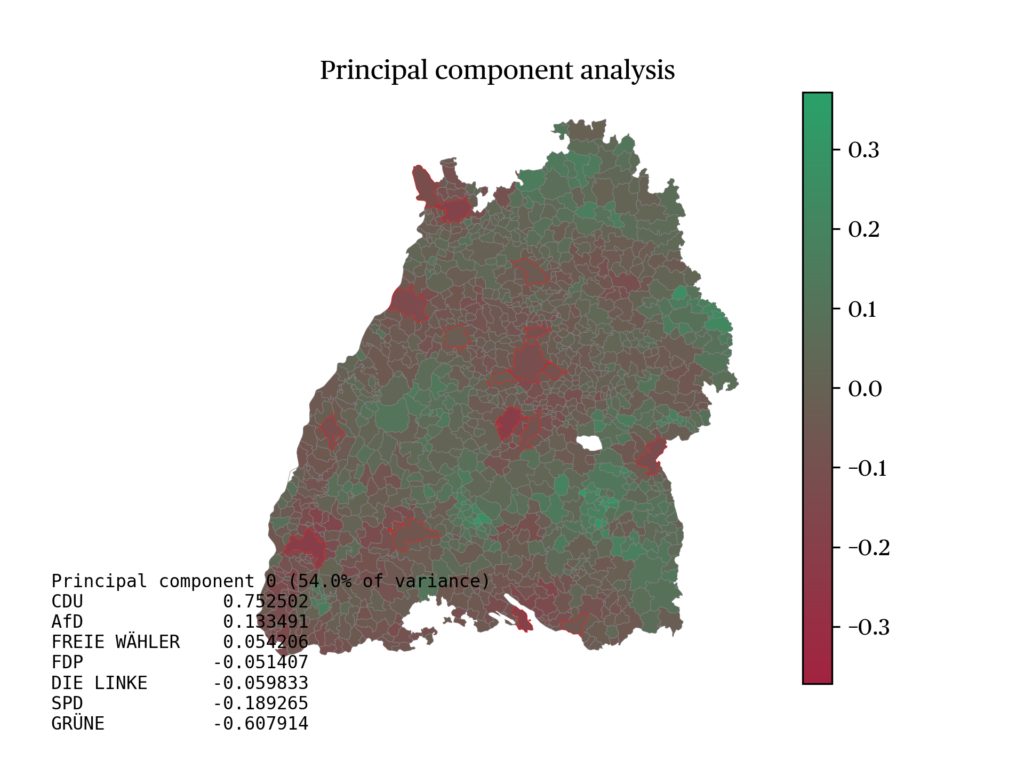
a • Principal component analysis of the 2021 vote: first eigenvector 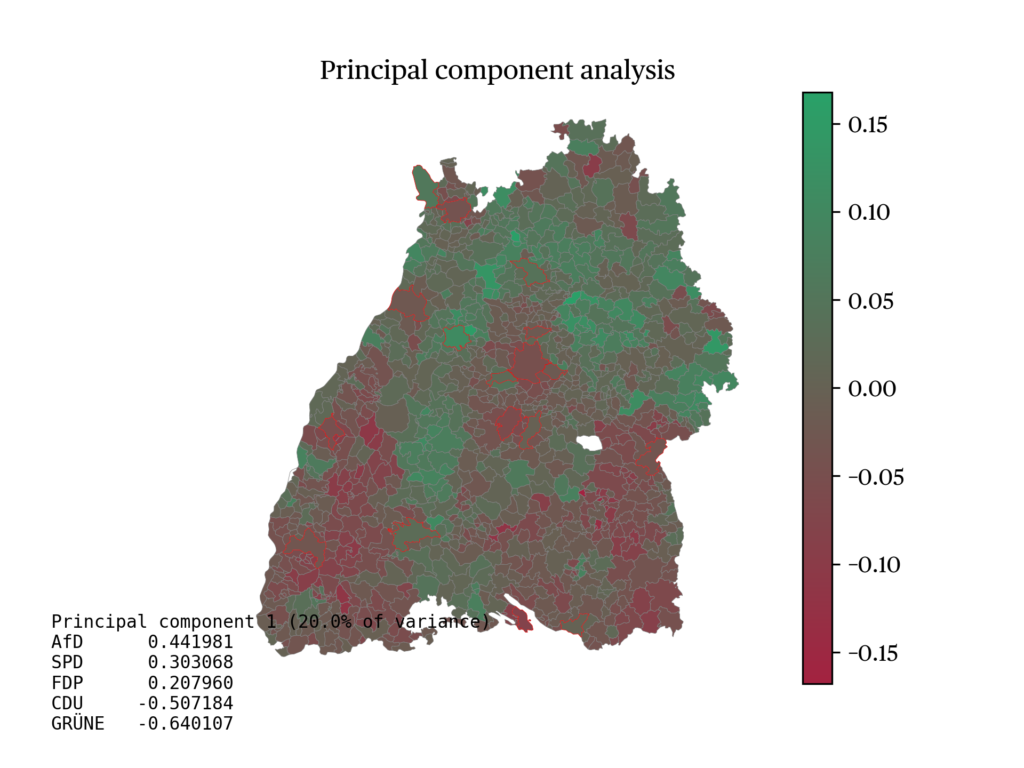
b • Principal component analysis of the 2021 vote: second eigenvector
Trends in content
A substantive assessment of the state elections must take into account the current context of the Covid-19 pandemic. The crisis, which led to considerable restrictions in public life and in the exercise of fundamental rights while also causing existential concerns among the population, overshadowed other unrelated issues. However, this did not mean that the election campaign revolved exclusively around the fight against the pandemic. Still, the crisis meant that political attention was focused on pandemic control and thus on the state government or, more specifically, on Minister President Kretschmann. At the same time, challenger parties found it difficult to run their campaign, as they were receiving less media attention and were hardly able to conduct classic election campaigns with analogue events, citizens’ dialogues, etc. The strong focus on the crisis management of the state government and the relatively few opportunities for conventional campaigning make it difficult to assess citizens’ political priorities, as far as issues aside from the Covid-19 pandemic are concerned.
When assessing the topics that were perceived as most important independently of the pandemic, it is striking that environment and climate were assigned a comparably high priority (19%) alongside with economics (22%) (Infratest-dimap 2021c). Hence, the pandemic did not significantly distract attention from the longer-term issue of climate change. The third most important topic was social justice (16%), followed by education and schooling (15%) (ibid.). The fact that Kretschmann’s government managed to deal with these and other issues satisfactorily probably stems from his largely non-ideological and pragmatic style of government and his image of proximity to citizens, rather unusual for a Green Party politician.
An indication that the CDU could regain strength stems from the citizens’ evaluation of the expertise of the respective parties in various policy domains. Although other factors than the mere evaluation of capabilities determine a party’s chances of success, the recognition of expertise in as many policy areas as possible is a necessary condition for electoral success, making it an indicator worth considering. For example, the CDU in Baden-Württemberg is being attributed similar expertise as the Greens in the important policy fields of education, economics and transport, as well as in the currently particularly relevant Covid policy. They are attributed a somewhat higher expertise in the area of economic policy (Figure d, Forschungsgruppe Wahlen, 2021b). The Greens are only perceived as significantly more competent in the field of environmental and climate policy, which shows that the CDU has the chance to win back trust and support in a majority of policy fields — at least as long as these policy fields do not continue to be overshadowed by environmental and climate policy, which currently enjoys a high priority in society.
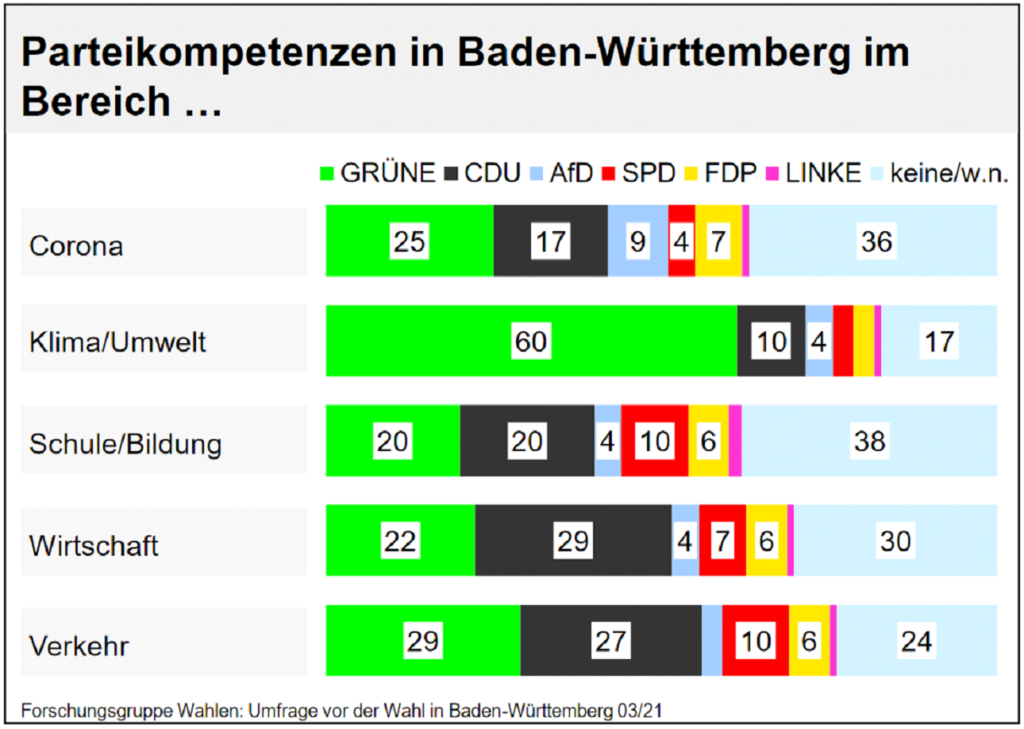
Geographical trends
When comparing the election results in the constituencies, several findings stand out. The fact that the AfD finds less support in urban areas than in rural regions is also reflected in this state election, as is the fact that it can generate the least support in university towns. This finding is not surprising, but in comparison to the CDU, which is also less successful in urban areas than in rural ones, it is apparent that the difference in success between rural and urban areas is greater for the CDU than for the AfD (Figures d-e). While the CDU and the AfD are the only parties to show a (slight) decrease in approval ratings between rural and urban areas, the Greens and the SPD show an upward trend (Figures f-g). The Left Party also shows an upward trend, but at such a low level that it still failed to enter the Landtag. The FDP, on the other hand, is voted with largely equal frequency in rural and urban areas.
Although there is a tendency for the Greens to gain support in urban areas (especially university towns), the spread is quite wide. A closer examination of constituency results shows that the Greens achieved particularly high approval ratings in all urban constituencies, but also, to a large extent, in the rural areas of South-West Baden-Württemberg near the borders with France and Switzerland (Figure h). While this state election confirms that the Greens are strongest in urban regions, it also shows that they are quite capable of conquering rural regions — an indication that should not be forgotten in the perspective of the upcoming federal election.
The CDU, which had been the party of the Minister President since 1953 before the Greens took over the state government ten years ago, is still the Greens’ biggest competitor. Despite the stable strength of the Greens, the CDU can rely on their success in many larger constituencies, as well as stably strong results in the Eastern and North-Eastern constituencies bordering Bavaria (Figure i). The Greens won 58 and the CDU 12 of the 70 constituencies. The fact that the SPD was able to win individual municipalities, but no constituencies, is generally explained by the lack of a unionised working-class milieu in the region (Debus, 2017:20). This explanation in terms of missing socio-structural premises is theoretically based on a micro-sociological approach to electoral behavior.
Coalition-building
While experts were assessing the possible coalitions in the run-up to the election, speculation arose about the possibility of a coalition of Greens and SPD. The SPD is politically and ideologically more closely aligned with the Greens than the CDU, and seemed to be able to profit from a progressive cooperation. However, the election outcome gave a coalition of Greens and SPD exactly 50% of the seats — the one seat missing to attain a majority eventually thwarted this possibility (see “data” panel). Thus, the only remaining options were a continuation of the Green-Black coalition or a “Traffic-Light” alliance between Greens, SPD and FDP, a combination never experienced before in Baden-Württemberg. In the run-up to the election, Kretschmann did not specify with whom he would prefer to form a government. The FDP, like the SPD, was open to such a coalition. After an controversial internal debate, the Greens eventually decided to govern with the Conservatives. As “Green-Black” had been able to govern in a stable and smooth manner during the past four years, this decision was not unexpected. In a pre-election survey, 44% of respondents expressed a positive opinion about this coalition model, while 33% disapproved it. In contrast, the “Traffic-Light” coalition was view negatively by 51%, and positively by only 28% (Forschungsgruppe Wahlen, 2021b).
Looking at the new Green-Black coalition from a theoretical perspective, coalition theory suggests four factors explaining the outcome of the government formation process:
- electoral results and number of seats (for the purpose of office-seeking); 2
- substantive political positioning; 3
- institutional and contextual factors; 4
- negative or positive statements by the parties about possible coalitions. 5
The first factor comes into play in the explanation of the continued coalition, as the formation of a government of two parties instead of three allows for the possibility of maximising their holding of political offices. The second factor points to the fact that party forming coalitions try to compromise as little as possible in terms of content. In this respect, the coalition of the Greens with the CDU does not appear as a natural choice, but the rifts were already bridged by the previous coalition of the two parties, so that this factor plays a lesser role in the continuation of the government. This is expressed, for example, in the Greens’ statement that climate protection policies would be easier to pursue with the CDU than through a “Traffic-Light” coalition. The context of shared government experience and its well-rehearsed functioning correspond to the third factor that explains this coalition formation. A contextual factor to consider at this point is the fact that the Greens emerged as the winners of the election and the CDU as the losers, which reinforced the hierarchy between the two partners within the coalition. In a “Traffic-Light” coalition, the position of the Greens as a coalition leader would have been much less dominant : the FDP, as the second preceived election winner, would have been likely to make strong political demands, which would have highlighted the greater ideological divide between the parties. Finally, the absence of significant conflicts between the Greens and the CDU during the campaign reflects the fourth factor ; this constructive approach of the parties already indicated that a continuation of the coalition was not only possible but also probable.
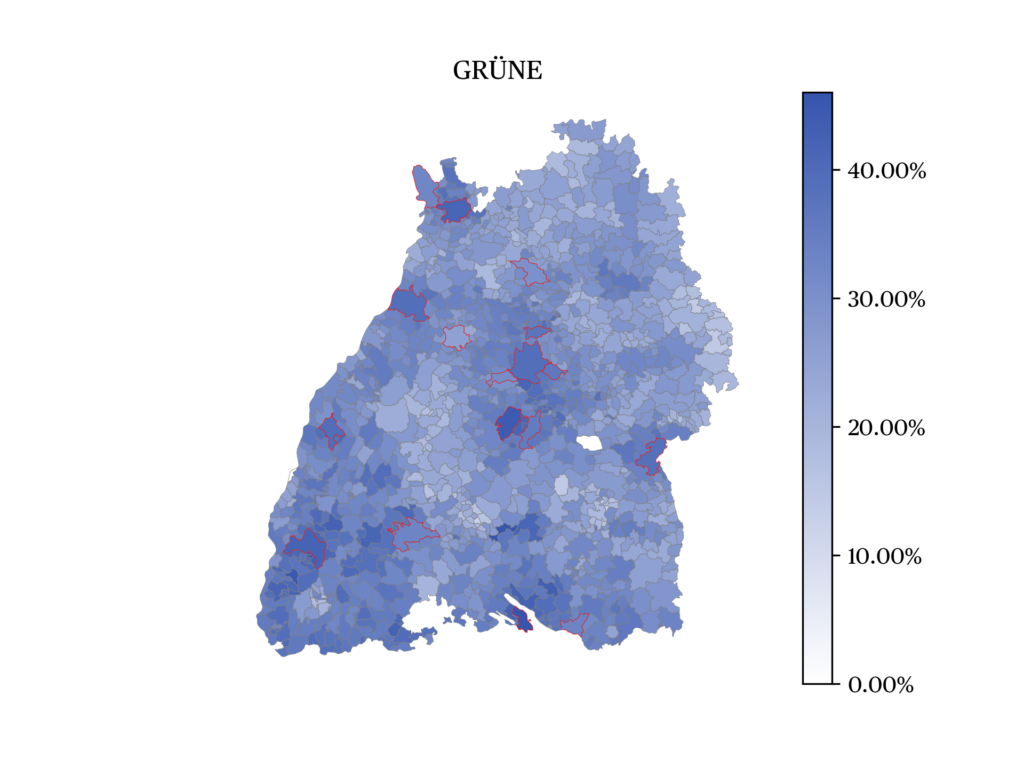
h • Green scores by municipality 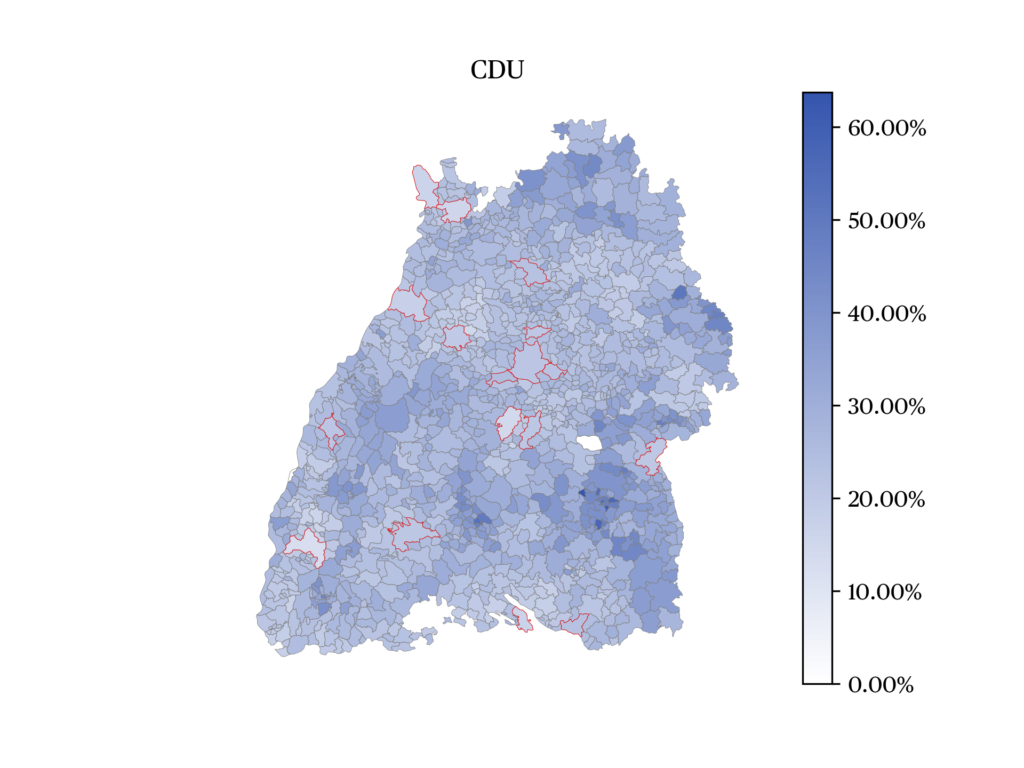
i • CDU scores by municipality
Impact of the election on federal politics and the federal election in September 2021
Regional political events and dynamics are relevant for federal politics in two respects. On the one hand, Lande elections reflect to a certain extent the political climate of federal politics and give an idea of prevailing tendencies, while on the other hand, the state level can serve as an experimentation ground for coalition options at the federal level (Eith, 2008:118). The latter is relevant in the context of the upcoming federal election, as the Green-Black government in Baden-Württemberg and the Black-Green government in Hesse can be seen as models of a future coalition between the Greens and the CDU in the federal government. Even if other coalition options are possible, the experiences from Baden-Württemberg and Hesse will play a role for the Greens and the CDU.
The good performance of the Greens in Baden-Württemberg, the third largest state of Germany (both in terms of area and population), puts the party in a good starting position at the beginning of this “super election year.” While the party is unlikely to reach similar levels at the federal level, the result nevertheless has a certain appeal that should give the Greens momentum in the federal election campaign. One major difference between the Green electorate in Baden-Württemberg and its nationwide counterpart is generational: the age structure of Green voters in Baden-Württemberg is almost balanced, whereas, in Germany as a whole, it is mainly younger age groups who increasingly vote Green (Forschungsgruppe Wahlen, 2021b:2 ; Infratest dimap, 2019). In this respect, the support potential of older age groups in Baden-Württemberg cannot be compared to that of the same age groups at the federal level. On the other hand, the two leading candidates of the Greens at the regional and federal levels respectively, Winfried Kretschmann and Annalena Baerbock (who is also candidate for chancellor), have different appeal to the electorate. While Kretschmann advertised continuity (“You know me”), while Baerbock focuses on transformation and change. As a much younger candidate, she also stands for a more dynamic style of politics than Kretschmann. Baerbock could benefit from this difference, however, if she succeeds in combining her transformative political demands with references to the stability of the Green state government of Baden-Württemberg and the economic prosperity of the Green-led state (Statistisches Landesamt Baden-Württemberg, 2020). She could thus alleviate the scepticism of more conservative voters towards her.
While the election result provide momentum to the Greens’ platform, it also represents the first obstacle in the CDU’s federal election campaign, which, with its relatively weak performance, did not start the year on a promising note. However, the CDU’s result must also be contextualised, taking into account the discontent with the federal government’s crisis management at the time of the election. Likewise, the corruption scandals revolving around some CDU members of the Bundestag, who came under heavy criticism with — at the very least — morally reprehensible deals involving medical equipment, questionable secondary revenues and deals with Azerbaijan, will have weighed somewhat on the CDU in Baden-Württemberg towards the end of the election campaign.
The AfD started the super-election year with harsh losses in one of its few strong regions in western Germany. This reflects its current difficulties in parliament. Not only had the AfD in Baden-Württemberg attracted attention since 2016 because of internal disputes over substantive orientations : conflicts are also becoming increasingly prominent in the federal party. In its first term in the Baden-Württemberg state parliament, the AfD parliamentary group struggled with resignations, scandals over donations and expulsions. This could well explain its poor regional performance. It also indicates the main challenges that the AfD will face in the upcoming federal election campaign. However, despite its many recent difficulties, a certain core constituency of AfD voters seems to have emerged that remains largely loyal to the party regardless of the context (Politico, 2021). While in Baden-Württemberg this electorate only reaches moderate proportions, the AfD can rely on a significantly larger voter base in Eastern German Länder, which gives the party significant weight in government formation processes despite the refusal of all other parties to form of a coalition with them.
For the FDP and the Left, Baden-Württemberg hardly has any significant federal implications, as the Left was unlikely to win seats in the region and the FDP’s position has not changed compared to 2017, which can be attributed to the party’s mostly insignificant performance at the state level.
Bibliography
Brettschneider, F. (2021). Aus den Ländern (Baden-Württemberg) — Analyse der Landtagswahl 2021. Wirtschaftsrat Deutschland. Online [last accessed 03.06.2021].
Debus, M. 2009. Pre-electoral commitments and government formation. Public Choice 138 (1–2): 45–64.
Debus, M. (2017). Verrückte Verhältnisse? Wahlverhalten und Parteienwettbewerb in Baden-Württemberg zwischen 2011 und 2016. In Hörisch, F. (ed.): Das grün-rote Experiment in Baden-Württemberg : eine Bilanz der Landesregierung Kretschmann 2011-2016. Wiesbaden: Springer VS, pp. 15–45.
Eith, U. (2008). Das Parteiensystem Baden-Württembergs. In Jun, U., Haas, M. and Niedermayer, O. (eds.): Parteien und Parteiensysteme in den deutschen Ländern. Wiesbaden: VS Verlag für Sozialwissenschaften, pp. 103 -123.
Forschungsgruppe Wahlen e.V. (2021a). Wahlen 2021 — Baden-Württemberg 2021. Online [last accessed 11.05.2021].
Forschungsgruppe Wahlen e.V. (2021b). Landtagswahl in Baden-Württemberg 14. März 2021. Online [last accessed 11.05.2021].
Infratest dimap (2019). Europawahl 2019. Deutschland. Umfragen und Wähler nach Altersgruppen. Online [last accessed 11.05.2021].
Infratest dimap (2021a). Baden-Württemberg Trend März 2021. Online [last accessed 11.05.2021].
Infratest dimap (2021b). Von diesen Parteien haben die Grünen ihre Stimmen gewonnen. Wählerwanderung. Online [last accessed 11.05.2021].
Infratest dimap (2021c). Kretschmann kam an, Eisenmann gar nicht. Wahl in Baden-Württemberg. Online [last accessed 11.05.2021].
INSA (2021). Sonntagsfrage – Bild – Wahlcheck. Jahrestrend 2021. Online [last accessed 11.05.2021].
Laver, M. and Shepsle, K.A. (1996). Making and breaking governments: Cabinets and legislatures in parliamentary democracies. Cambridge: Cambridge University Press.
Martin, L. W. and Stevenson, R.T. (2001). Government formation in parliamentary democracies. American Journal of Political Science 45 (1): pp. 33–50.
Politico (2021). Poll of Polls. Germany. Online [last accessed 03.06.2021].
Statistisches Landesamt Baden-Württemberg (2020). Wirtschaftsdaten Baden-Württemberg 2020. Online [last accessed 03.06.2021].
Statistisches Landesamt Baden-Württemberg (2021). Ergebnis der Landtagswahl 2021. Online [last accessed 11.05.2021].
Van Deemen, A. M. A. (1989). Dominant players and minimum size coalitions. European Journal of Political Research 17 (3): pp. 313–332.
The Data
Notes
citer l'article
Oliver Drewes, Parliamentary Election in Baden-Württemberg, 14 March 2021, Sep 2021, 38-44.
à lire dans cette issue
voir toute la revue






